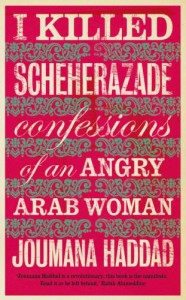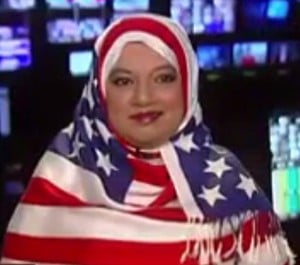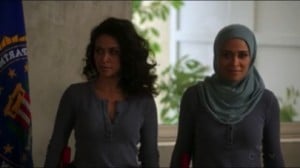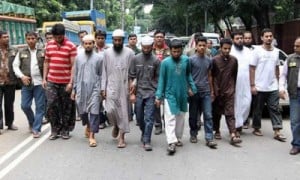When Lebanese writer and poet Joumana Haddad’s I Killed Scheherazade: Confessions of An Angry Arab Woman was published in 2010, it was described as a bold treatise, intentionally designed to be revolutionary, written in manifesto style. Recently, a revived interest has situated it in more superficial terms as “a provocative new book which “lifts the veil” on what the “Arab Spring” really means for women,” with Haddad as the liberated Arab woman telling all about her unliberated sisters. In fact, this theme is so familiar some have made the mistake of describing Haddad as the brave provocateur Muslim woman, along the lines of Irshad Manji, despite the fact that Haddad is an agnostic who who grew up in a conservative Catholic family.

It is fitting however that her book, I Killed Scheherazade, is described as provocative, since in the book’s Foreword, Haddad explains that it was provoked by the words of a journalist interviewing her, who noted, “Most of us in the west are not familiar with the possibility of liberated Arab women like you existing.” In response, Haddad retorted “There are many “liberated Arab women” like me. And if you are not aware that we exist, as you claim, then it is your problem not ours.”
Later regretting her “defensive reaction,” she attempts to explain it in writing I Killed Scheherazade, which takes on prejudice, hypocrisy and religious bigotry in rapid-fire blunt prose. In the opening, Haddad promises to deprive the Western reader of “chimeras and ready to wear opinions” but writes that her book is primarily addressed to “fellow Arab citizens.” She situates the book as first and foremost an effort of self-criticism, illustrating the real dilemmas in the Arab world, because “no effort of self-defence deserves to be taken seriously if it is not accompanied and sustained by an effort of self-critism.”
And so, Haddad attempts to break western stereotypes about the Arab world at the same time as her book brims with anger and resentment at Arab failures, attacking the lack of critical thinking and the herd instincts of populations afraid to ask questions: “The Arab mind cannot handle questions, because questions can hurt and upset the murky calm of the swamp.” As M. Lynx Qualey points out, Haddad could be seen as disqualifying her own project: “So, if Haddad is an Arab, then I assume she cannot handle questions that upset the murky calm of her swamp? Right?”
Haddad is celebrated more in the West than in Lebanon, yet as Qualey argues, she is far from being Lebanon’s Nawal al-Saadawi, and the generalizing politics of her self-criticism have been described as problematic by many who see it as taking on a mantle of the taboo-breaking revolutionary, hating and hated by her own country, with an accompanying replication of stereotypes about Arab culture. See for example, “An Open Letter to Joumana Haddad” which points out “the huge problematic with statements like “The Arab mind is in crisis.”” (Joumana Haddad responded directly the post in the comments section.)
In one chapter of her book, however, Haddad does become more specific about her anger and resentment, taking on the comments that suggest that she was fortunate to be born into a Christian family: “Had you been a Muslim woman you’d never have been able to write what you write.” Haddad responds to this declaration of “skeptical, judgemental, predjudiced Western minds” by quoting St Paul, “Let the woman learn in silence, with all subjection.”
In her interviews, Haddad often describes her own upbrining in a strict Catholic home by over-protective parents, writing that ”I couldn’t even go to the movies without my brother, or to a friend’s house without my mother waiting there for me – even when I was 17.” Her way to establish her own independence was to marry at 19. ”It wasn’t a passionate act. It was my only way out.” She attacks the idea that Christianity is “better” for Arab women, although she is keen to point out that this is not as “a defense of Islam nor a prosecution of Christianity.” For Haddad also argues that Islamic feminism is “an internal contradiction,” and does not accept that a woman can be liberated while choosing to wear hijab. For Haddad, you can not be free in either religion: “I’m convinced that religion in general is one of the worst enemies of women’s emancipation.”
Yet her conviction seems to have been generally ignored. See, for example, this review, which points out that Haddad is fortunate in being not Muslim:
“Haddad was fortunate to grow up in Lebanon and not a country like Saudi Arabia. Second, the uniqueness of her own childhood provided her with an exposure to a world not typically Arab. Her family is Christian, not Muslim, and her father’s library contained a number of books not often found in Arab households.”
This is part of a long standing tradition which situates Arab Christians as “not typically Arab,” including as being isolated and endangered by the current events in the region. Kevin Meyers, for example, feels confident in making a blanket assertion that Arab Christians do not regard the upsurge across the Middle East as any kind of liberation.
This tradition of the “not typically Arab” Christian community feeds into Haddad being desribed as the Carrie Bradshaw of Beirut, despite the fact that Haddad states that the purpose of her work is not to emulate the West. Instead, her work reflects the dilemmas of women in Arab societies and takes aim at Arab women themselves – for not doing enough to fight back. And this is where the archetype of Scheherazade is invoked. For Haddad, Scheherazade needs to be killed because she sends the wrong message: “persuade men, give them the things that you have and they want, and they’ll spare you.”
“I’ve never been a big fan of Scheherazade, who, to make matters worse, is nauseatingly cherished by the Orientalists….I’ve had just enough people (especially in the West, but in the Arab world as well) turning her into a heroine, the symbol of Arab cultural female opposition and struggle against men’s injustice, cruelty and discrimination…. Things simply needed to be put in their right perspective.
Thus, I killed her.”
As part of this killing of Scheherazade, Haddad works to dismantle the dominant image of The Arab Woman in the West as a victim. Although her definition of “the liberated woman” need not be taken as the same as all other Arab women, Haddad refuses the image of Arab women as a mass of silent suffering and sees instead individuals, by both acknowledging the existence of the Arab woman “who doesn’t have any decision over her body, her life” and arguing that there are Arab woman who are liberated and emancipated.
In an interview with Marie Claire, this distinction becomes bewildering: “You argue that Arab women are liberated. But then we read that a Saudi woman is lashed for the “crime” of being raped.”
The confusion between the invention of The Arab Woman and the realities of Arab women can be compared to Lamia Zayzafoon’s apt question in her book, The Production of the Muslim Woman: ‘[i]f we grant that the image of the “Muslim woman” is invented, does this mean that the different forms of oppression she is subjected to are also invented?”
It is a balance Haddad attempts to maintain by reiterating that she not trying to present a different reality, but instead working to show that there is more than one reality, that while “the Arab woman as she is represented in the shape of the veiled, oppressed, subdued victim exists,” there is also another Arab woman who “represents hope for the first one.”











